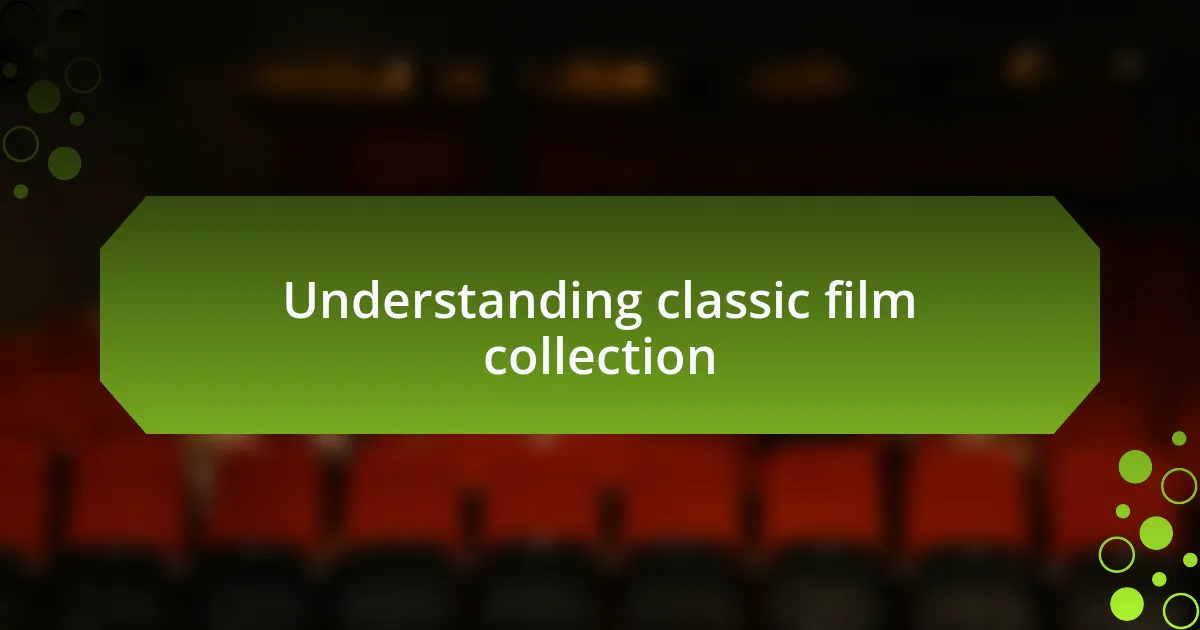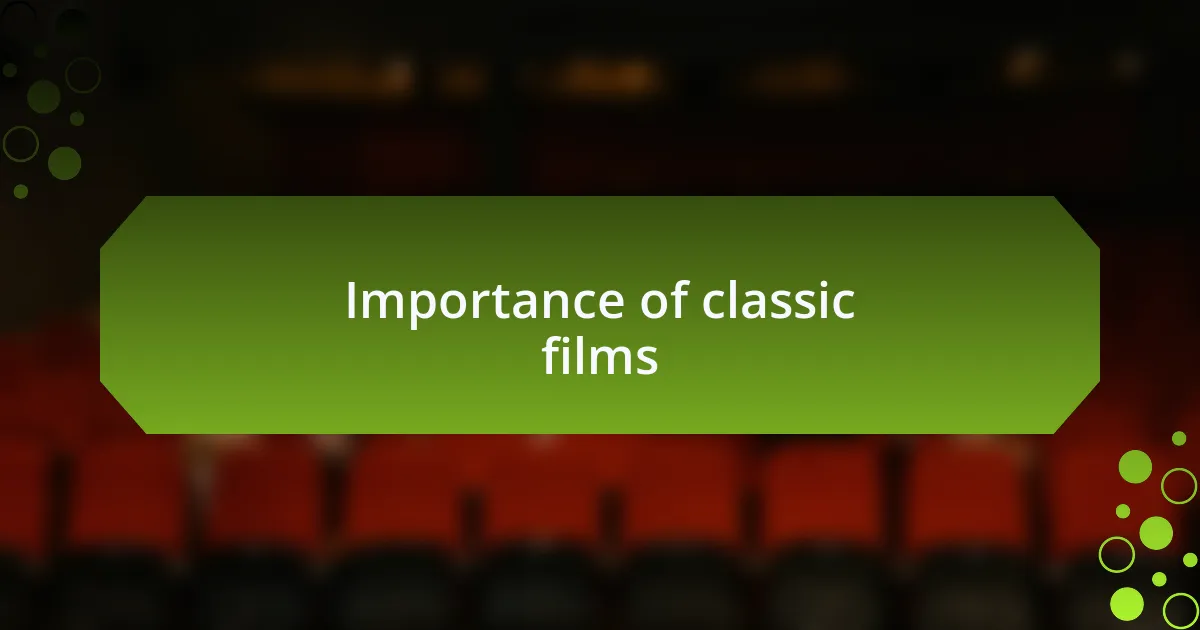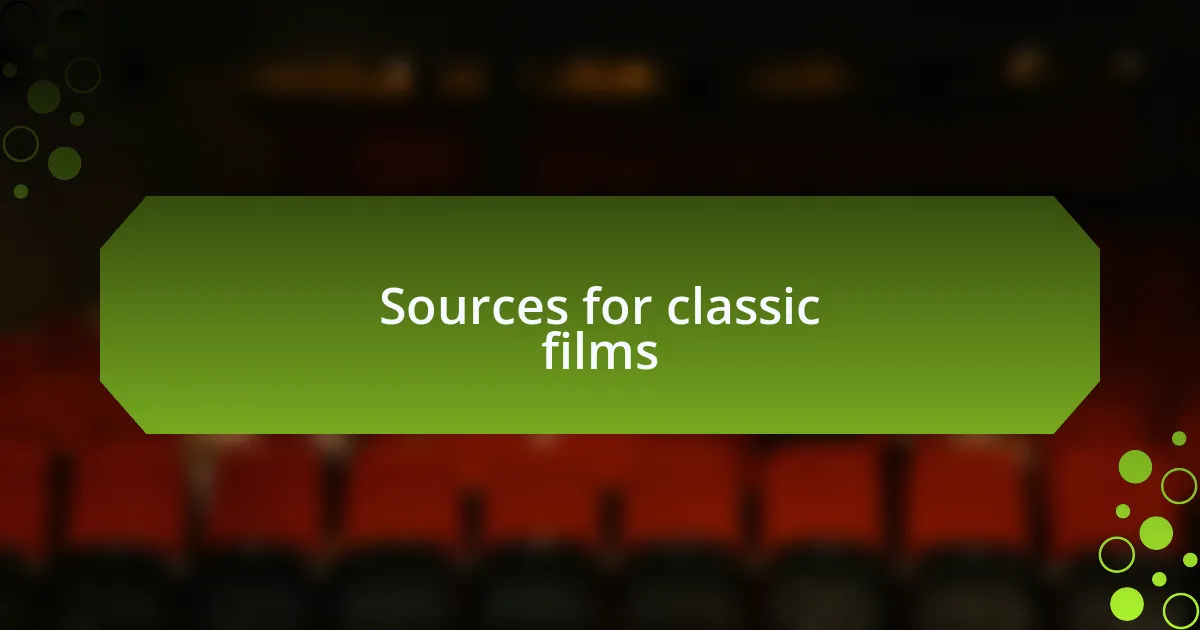Key takeaways:
- A classic film collection reflects significant cultural moments and evokes timeless emotions, connecting generations through universal themes.
- Classic films serve as cultural touchstones and offer insights into societal norms, prompting reflection on personal beliefs and values.
- Choosing films for a collection involves considering personal resonance, historical significance, and emotional impact.
- Maintaining a collection includes proper storage, regular cleaning, and keeping a digital inventory to enhance organization and accessibility.

Understanding classic film collection
A classic film collection is more than just a set of movies; it’s a curated journey through cinematic history. I remember the first time I stumbled upon a black-and-white classic at a flea market. It was like discovering a treasure trove of stories that had shaped the very essence of film. Each title in a classic collection reflects significant cultural moments, showcasing the artistry and perspectives of its time.
When I think about what constitutes a classic film, I often consider the emotions it evokes. Have you ever watched a film that, despite its age, made you feel like you were experiencing something timeless? It’s remarkable how these films speak to universal themes that resonate across generations. Titles like “Casablanca” or “Gone with the Wind” draw you into their world and leave you pondering long after the credits roll.
As I build my collection, I seek out films that not only entertain but also educate. There’s a distinct joy in finding those lesser-known gems that challenge the mainstream narrative. What’s more satisfying than sharing a forgotten classic with a friend and seeing their eyes light up? Each film becomes a conversation starter, a way to connect and share insights that transcend the screen.

Importance of classic films
Classic films hold immense significance for a myriad of reasons. Personally, I’ve often found that they serve as cultural touchstones, helping to bridge generational divides. For example, the first time I screened “Roman Holiday” for my younger sibling, they were surprised to discover how relevant its themes of freedom and adventure still are today. This experience made me realize that classic films can ignite meaningful conversations about the values and experiences that shape our lives.
Moreover, classic films encapsulate the evolution of storytelling and technology in cinema. I remember watching a silent film and being captivated by how emotions were conveyed through expressions alone, without a single spoken word. It made me appreciate the foundation these films have laid for modern filmmaking techniques. This reflection often leads me to wonder—how would contemporary films differ if those early pioneers had never taken risks to innovate?
In a way, classic films challenge us to reflect on our own lives and societal norms. I’ve often turned to classics during moments of personal uncertainty, finding solace in their narratives. Watching something like “12 Angry Men” not only entertains but also sparks introspection about justice and morality. Isn’t it fascinating how a film made decades ago can still prompt us to question our own beliefs and choices today?

Choosing the right films
Choosing the right films for my collection often feels like an adventure. I focus on films that resonate with me on a personal level and reflect a diverse range of stories. For instance, discovering “Casablanca” was a game-changer; it’s not just a love story, but a deep exploration of sacrifice and duty that left me contemplating my own sacrifices in life.
I also consider the historical significance of certain titles. When I decided to add “The Wizard of Oz” to my library, I didn’t just see it as a childhood favorite; I recognized its importance in breaking boundaries in color cinematography and storytelling. How often do we stop to think about what makes a film groundbreaking, and how it influences everything that follows? Each viewing offers a new layer of appreciation and insight.
Additionally, the emotional response a film evokes plays a crucial role in my selection. The first time I watched “The Graduate,” the ending left me feeling both ambivalent and enlightened about life’s complexities. This duality sparks questions about choices and the paths we take. Isn’t it remarkable how a single film can make us reflect on our own transitions and decisions? That’s what I seek when curating my collection.

Sources for classic films
Finding reliable sources for classic films has transformed my collection journey. I often turn to specialized streaming services, like the Criterion Channel, which offers a carefully curated library. Their dedication to preserving and showcasing classic cinema helps ensure I’m diving into films that are both influential and artistically significant.
Local libraries have also been a surprising gem in my search. I remember stumbling upon a treasure trove of classic film DVDs at mine, including titles I had only heard about in film classes. The thrill of checking out a piece of cinematic history, like “12 Angry Men,” reinforces the idea that classic films are more accessible than they often seem. Hasn’t anyone else experienced that rush of nostalgia when handling these films as if they hold secrets of the past?
Moreover, attending film festivals or retrospectives can be a great way to discover hidden classics. I’ll never forget the time I attended a screening of “Sunset Boulevard” outdoors in a park. Watching it among fellow film lovers, each reaction amplified the film’s brilliance in a communal experience. Isn’t it a wonderful feeling to share insights and emotions with others who appreciate the same timeless narratives?

Organizing your film collection
When it comes to organizing my film collection, I find that categorization is key. I prefer to sort my classics by era and genre, making it easier to locate a specific title when I’m in the mood for, say, a thrilling film noir from the 1940s or a heartwarming romantic comedy from the 1960s. This system not only reflects my tastes but also enhances the viewing experience by inviting me to revisit films based on my nostalgia-driven whims.
I remember the satisfaction of creating a dedicated space for my collection. I cleared out a shelf, each movie carefully lined up, their spines showcasing iconic artwork. The thrill I felt gazing at my curated selection reminded me of how films capture moments in time. Have you ever experienced that? It’s not just about the films themselves; it’s about the memories attached to them, like sharing a classic with friends during a chilly evening in.
Every so often, I also take the time to re-evaluate my collection. I ask myself if certain films still resonate with me or if they could find a new home with someone else. This process is quite cathartic, allowing me to reflect on how my tastes have evolved over the years. Isn’t it fascinating how a film that once captivated you might not hold the same magic later on? I’ve birthed new interests while reluctantly saying goodbye to films that have served their time.

Tips for maintaining your collection
Maintaining a classic film collection goes beyond good organization; it’s also about preservation. I ensure that my films are stored in a cool, dry place away from sunlight, as heat and moisture can cause irreversible damage. There’s nothing more disheartening than pulling out a beloved film only to discover a warped or scratched disc. Have you ever lost a treasured movie? That feeling is why I prioritize protective sleeves that shield the cases from dust and wear.
I also believe regular cleaning is crucial. After a few viewings, I like to gently wipe the discs with a microfiber cloth to remove fingerprints and dust. It’s a small step that can make a big difference in ensuring a smooth playback experience. Plus, there’s a certain ritual to it that feels almost meditative; like I’m nurturing a piece of art. Do you have a favorite film that deserves that extra care?
Finally, I make it a habit to keep a digital inventory of my collection. I include details like the film’s release year, director, and personal ratings. This not only helps me remember what I have but also serves as a quick reference for when friends ask for recommendations. I once found myself standing in a friend’s living room, trying to recall whether I owned a particular film. That awkward moment prompted me to take organization a step further. Is there a title you often find yourself searching for, only to realize it’s right there on your shelf?

Personal favorites in my collection
One of my all-time personal favorites in my collection is “Casablanca.” The moment I press play, I’m whisked away to a time of romance and intrigue, and I can’t help but feel a rush of nostalgia. I remember the first time I watched it; the dialogue resonated with me, almost as if I were meant to experience that poignant love story. Does a film ever evoke such a strong emotional response for you?
Another cherished title is “The Godfather.” Its storytelling depth and iconic performances have led me to watch it multiple times, each viewing revealing new layers of complexity. I often find myself debating with friends over which scene is the best—do you lean towards the opening wedding or the tense finale? These discussions add an extra layer of enjoyment to the experience, highlighting how this film can continuously spark conversation.
Then there’s “Rear Window,” a film that immerses you not just in the story but in the art of filmmaking itself. The way Hitchcock crafts tension through a single vantage point always blows my mind. I recall watching it late at night, the suspense so palpable that I jumped at the slightest sound outside my window. Have you ever found a film that heightened your senses in such unexpected ways?